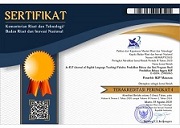CULTURAL ARTIFACTS IN STUDENTS’ LITERACY NARRATIVE
Abstract
Literacy narrative is students’ writing. The students write their experiences in pass about how they learn reading, writing, speaking or listening in English. Students’ literacy narrative tells their effort to change identity from positional identity to figurative identity by using cultural artifacts. This study presents to identify the cultural artifacts to improve the students’ figurative identity through students’ literacy narrative. The objectives of study are to identify the cultural artifacts that use to change their identity by using literacy narrative. Qualitative research used to identify the cultural artifacts through students’ literacy narratives assignment and interview. The samples of the study are 20 students of senior high school. The finding result showed cultural artifacts are as tools to change their identity as a poor writer to be a good identity. Based on the students’ literacy narrative almost all of the students change their identity by cultural artifacts as books and English program (extracurricular). But some others, they joined English course beyond the school’s program. Considering the findings, this research highlights the need several times to identify the kinds of students’ identity by using ethnography.
Keywords
Full Text:
PDFReferences
Alwasilah, A. C. (2000). Pokoknya kualitatif: Dasar-dasar merancang dan melakukan penelitian kualitatif.
Ary, D., Jacobs, L. C., Razavieh, A., & Sorensen, C. K. (2010). Introduction to Research in Education. Wadsworth: Belmont, USA.
Culberson, L. C. (1993). Arrowheads and Spear Points in the Prehistoric Southeast; A Guide To Understanding Cultural Artifacts. United States America: The University Press of Mississippi.
Givens, S. M. (2010). Using affective assessment to understand our students’ identities as readers (and non-readers). Inquiry: The Journal of the Virginia Community Colleges, 15(1), 2.
Holland, D., Lachicotte, W., Jr, Skinner, D., & Cain, C. (1998). Identity and agency in cultural worlds. Cambridge: Cambridge, MA: Harvard University Press.
Leander, K. (2002). Locating Latanya: The situated production of identity artifacts in classroom interaction. Research in the Teaching of English, 37, 198-250.
Urrieta Jr, L. (2007). Figured worlds and education: An introduction to the special issue. The Urban Review, 39(2), 107-116.
DOI: https://doi.org/10.33394/jo-elt.v6i1.2353
Refbacks
- There are currently no refbacks.
Copyright (c) 2019 R. R Setyaningrum

This work is licensed under a Creative Commons Attribution-ShareAlike 4.0 International License.
Jo-ELT (Journal of English Language Teaching) Fakultas Pendidikan Bahasa dan Seni Program Studi Pendidikan Bahasa Inggris IKIP is abstracted/indexed in the following databases:
Published by Faculty of Culture, Management, and Business
Universitas Pendidikan Mandalika
p-ISSN: 2355-0309 | e-ISSN : 2548-5865
email: [email protected]
 Jo-ELT (Journal of English Language Teaching) Fakultas Pendidikan Bahasa dan Seni Program Studi Pendidikan Bahasa Inggris IKIP is licensed under a Creative Commons Attribution-ShareAlike 4.0 International License.
Jo-ELT (Journal of English Language Teaching) Fakultas Pendidikan Bahasa dan Seni Program Studi Pendidikan Bahasa Inggris IKIP is licensed under a Creative Commons Attribution-ShareAlike 4.0 International License.





1.jpg)


.png)







1.png)

.png)








